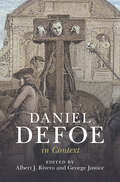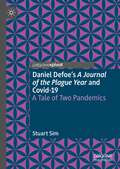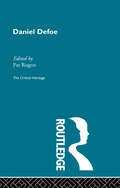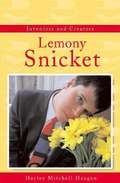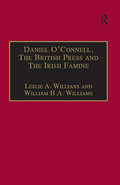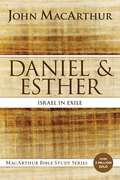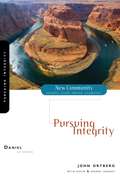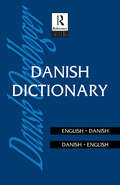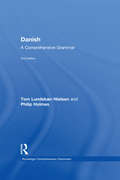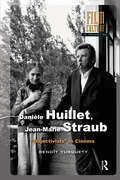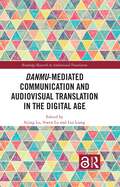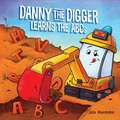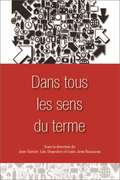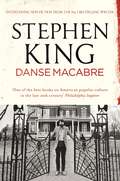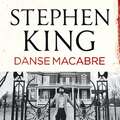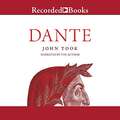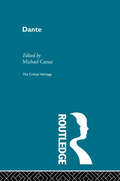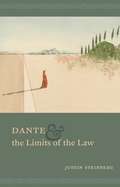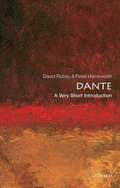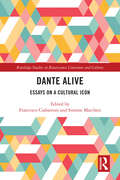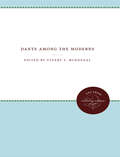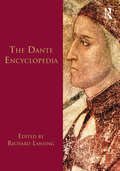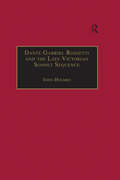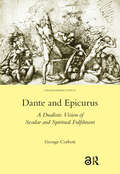- Table View
- List View
Daniel Defoe in Context (Literature in Context)
by Albert J. Rivero George JusticeInnovative in its structure and approach, Daniel Defoe in Context contains 42 essays by leading scholars illuminating the life, times, and world of Daniel Defoe. Defoe is one of the most important literary figures in English history, thanks not only to his pioneering novels Robinson Crusoe and Moll Flanders, but also to his notable works in journalism, travel writing, conduct literature, and verse, both satiric and serious. Written with general readers and students in mind, the essays in this volume provide up-to-date knowledge about eighteenth-century literature, culture, and history in a high quality, clearly written, but completely accessible form. Together they demonstrate the ways not only in which Defoe's world shaped his writing, but also in which Defoe's writings profoundly affected his world, and therefore our world.
Daniel Defoe's A Journal of the Plague Year and Covid-19: A Tale of Two Pandemics
by Stuart SimDaniel Defoe's A Journal of the Plague Year has taken on a new relevance with the advent of the Covid-19 pandemic. Through an exploration of two chronologically distant societies in crisis, this study compares the attitudes, beliefs, and conduct of the public portrayed in the book and those in our own embattled Covid era. There are interesting similarities to note, with equivalents to the Covid-deniers and the anti-vaxxers to be found in Defoe's bleak vision of London in the 1660s as it descends into a state of chaos. JPY offers us some uncomfortable truths about human nature that resonate strongly in our own times, revealing how responding to a pandemic can bring out both the best and the worst in our character as we face up to a world where the old certainties no longer seem to apply. Pandemics expose the fault-lines in ideology, putting the social contract at risk - the question they pose is whether we can continue to rely on our current socio-political set-up or whether it requires a radical rethink. There is a pressing need for more debate on this issue, and this project is designed to make a case for that.
Daniel Defoe, Contrarian
by Robert James MerrettA highly conscious wordsmith, Daniel Defoe used expository styles in his fiction and non-fiction that reflected his ability to perceive material and intellectual phenomena from opposing, but not contradictory perspectives. Moreover, the boundaries of genre within his wide-ranging oeuvre can prove highly fluid. In this study, Robert James Merrett approaches Defoe's body of work using interdisciplinary methods that recognize dialectic in his verbal creativity and cognitive awareness.Examining more than ninety of Defoe's works, Merrett contends that this author's literariness exploits a conscious dialogue that fosters the reciprocity of traditional and progressive authorial procedures. Along the way, he discusses Defoe's lexical and semantic sensibility, his rhetorical and aesthetic theories, his contrarian theology, and more. Merrett proposes that Defoe's contrarian outlook celebrates a view of consciousness that acknowledges the brain's bipartite structure, and in so doing illustrates how cognitive science may be applied to further explorations of narrative art.
Daniel Defoe: The Critical Heritage (Critical Heritage Ser.)
by Pat RogersFirst published in 1995. Routledge is an imprint of Taylor & Francis, an informa company.
Daniel Handler: The Real Lemony Snicket (Inventors and Creators)
by Hayley Mitchell HaugenWho is Lemony Snicket? Is he an author, an alter ego, or a character in the popular children's books, A Series of Unfortunate Events? Learn all about this mysterious guy in KidHaven's Lemony Snicket. This text sheds light on Snicket's childhood, his success as an author, the zany antics that have followed, and what he is up to today.
Daniel O'Connell, The British Press and The Irish Famine: Killing Remarks (The Nineteenth Century Series)
by Leslie A. WilliamsThrough an investigation of the reportage in nineteenth-century English metropolitan newspapers and illustrated journals, this book begins with the question 'Did anti-O'Connell sentiment in the British press lead to "killing remarks," rhetoric that helped the press, government and public opinion distance themselves from the Irish Famine?' The book explores the reportage of events and people in Ireland, focussing first on Daniel O'Connell, and then on debates about the seriousness of the Famine. Drawing upon such journals as The Times, The Observer, the Morning Chronicle, The Scotsman, the Manchester Guardian, the Illustrated London News, and Punch, Williams suggests how this reportage may have effected Britain's response to Ireland's tragedy. Continuing her survey of the press after the death of O'Connell, Leslie Williams demonstrates how the editors, writers and cartoonists who reported and commented on the growing crisis in peripheral Ireland drew upon a metropolitan mentality. In doing so, the press engaged in what Edward Said identifies as 'exteriority,' whereby reporters, cartoonists and illustrators, basing their viewpoints on their very status as outsiders, reflected the interests of metropolitan readers. Although this was overtly excused as an effort to reduce bias, stereotyping and historic enmity - much of unconscious - were deeply embedded in the language and images of the press. Williams argues that the biases in language and the presentation of information proved dangerous. She illustrates how David Spurr's categories or tropes of invalidation, debasement and negation are frequently exhibited in the reports, editorials and cartoons. However, drawing upon the communications theories of Gregory Bateson, Williams concludes that the real 'subject' of the British Press commentary on Ireland was Britain itself. Ireland was used as a negative mirror to reinforce Britain's own commitment to capitalist, industrial values at a time of great internal stress.
Daniel and Esther: Israel in Exile (MacArthur Bible Studies)
by John F. MacArthurMany of God's people through the ages have been called to endure times of hardship, loneliness, and suffering. Some, such as Daniel and Esther, were even members of a race carried away to a foreign land that had never heard of the God of Israel. Their lives were not easy, but even in the midst of trials, these men and women discovered that God was with them—and that He was actively leading the events in their lives.In this study, pastor John MacArthur will guide you through an in-depth look at the historical period of Israel's exile, beginning with the prophet Daniel being carried off to Babylon, continuing through the rise of the Persian Empire, and concluding with Esther's reign as queen.Studies include close-up examinations of Daniel, Nebuchadnezzar, Esther, Haman, and others, as well as careful considerations of doctrinal themes such as "Standing Boldly for God" and "God's Sovereignty Over the Future."—ABOUT THE SERIES—The MacArthur Bible Study series is designed to help you study the Word of God with guidance from widely respected pastor and author John MacArthur. Each guide provides intriguing examinations of the whole of Scripture by examining its parts and incorporates:Extensive, but straight-forward commentary on the text.Detailed observations on overriding themes, timelines, history, and context.Word and phrase studies to help you unlock the broader meaning and apply it to your life.Probing, interactive questions with plenty of space to write down your response and thoughts.
Daniel: Pursuing Integrity (New Community Bible Study Series)
by John Ortberg Kevin & HarneyStand Strong in Life&’s Furnaces How do you respond when the bottom drops out? What happens to your character quotient when things don&’t go the way you planned? How do you react when the temperature is rising, you are under attack, and God seems far away? Daniel discovered that the furnace experiences of life refine and define us. Spiritual integrity rarely grows when everything goes our way. Instead, God uses things like a furnace, a lion&’s den, a mad king, and exile in a foreign country to forge character in a soul. If you long to meet God in the challenging times and come through the fire stronger and more faithful, Daniel is ready to show the way.
Danish Dictionary: Danish-English, English-Danish (Routledge Bilingual Dictionaries)
by W. Glyn Jones Anna GardeFirst Published in 1995. This compact and up to date, two-way dictionary provides a comprehensive and modern vocabulary. It is an ideal reference for beginners or specialists. The maximum information is provided in the minimum space, making the dictionary an invaluable reference source.
Danish: A Comprehensive Grammar (Routledge Comprehensive Grammars)
by Philip Holmes Tom Lundskaer-NielsenDanish: A Comprehensive Grammar presents a fresh and accessible description of the language, concentrating on the real patterns of use in modern Danish. The volume is organized to promote a thorough understanding of Danish grammar. It offers a stimulating analysis of the complexities of the language, and provides full and clear explanations. This edition has been fully updated to reflect changes in grammar, cultural changes and the impact of modern technology. All sections have been systematically revised, and a new section on phrases and an up-to-the-moment account of the use of the comma have been added. The examples and grammar explanations have been improved throughout. Features include: a wealth of examples from present-day Danish particular attention to areas of confusion and difficulty Danish-English parallels highlighted throughout the book an extensive index and clear paragraph numbering for easy navigation cross-references in all parts of the book. Danish: A Comprehensive Grammar is the most comprehensive and detailed Danish grammar available in English and is an essential reference source for the learner and user of Danish at all levels. It is ideal for use in schools, colleges, universities and adult classes of all types.
Danièle Huillet, Jean-Marie Straub: Objectivists in Cinema (Film Culture in Transition)
by Benoît TurquetyDanièle Huillet and Jean-Marie Straub collaborated on films together from the mid-1960s through the mid-2000s, making formally radical adaptations in several languages of major works of European literature by authors including Franz Kafka, Bertolt Brecht, Friedrich Hölderlin, Pierre Corneille, Arnold Schoenberg, Cesare Pavese, and Elio Vittorini. The impact of their work comes in part from a search for radical objectivity, a theme present in certain underground currents of modernist art and theory in the writings of Benjamin and Adorno as well as in the Objectivist movement, a crucial group within American modernist poetry whose members included Louis Zukofsky, George Oppen, and Charles Reznikoff, with connections to William Carlos Williams and Ezra Pound. Through a detailed analysis of the films of Straub and Huillet, the works they adapted, and Objectivist poems and essays, Benoît Turquety locates common practices and explores a singular aesthetic approach where a work of art is conceived as an object, the artist an anonymous artisan, and where the force of politics and formal research attempt to reconcile with one another.
Danmu-mediated Communication and Audiovisual Translation in the Digital Age (Routledge Research in Audiovisual Translation)
by Sijing Lu Siwen Lu Lisi LiangThis collection represents the first of its kind, bringing together the latest research on danmu, the fast-growing phenomenon of live comments overlaid on audiovisual media changing the shape of audience participation on video-streaming platforms and of audiovisual translation research today.The volume presents compelling evidence of danmu's growing influence in shaping the future of audiovisual translation and online computer-mediated communication. Through diverse theoretical and methodological lenses, the chapters delve into how danmu facilitates audience participation, impacts documentary viewing through emotional engagement, and challenges traditional subtitling with multimodal pseudotranslations. It further explores cultural citizenship in video game commentary, virtual communities of practice in danmu, and Chinese audience preferences in danmu-enhanced viewing experiences.This book will be of interest to scholars in audiovisual translation, media studies, digital communication, and East Asian studies.Chapter 6 of this book is freely available as a downloadable Open Access PDF at http://www.taylorfrancis.com under a Creative Commons Attribution-NonCommercial-NoDerivs (CC BY-NC-ND) license.
Danny the Digger Learns the ABCs
by Aja MulfordJoin Danny, a young mini excavator, as he and his construction site friends take on a new job and learn the alphabet along the way!The perfect ABC book for any kid who loves excavators, cranes, dump trucks, backhoe loaders, and mixers, Danny the Digger Learns the ABCs is a follow-up companion to Danny the Digger Saves Christmas. Kids will love learning their letters as they explore the construction site with Danny. The joyful, full-color illustrations feature large, prominent letters that will help toddlers start to recognize letter shapes while also learning the names of vehicles and tools found on construction sites. A wonderful baby shower gift or birthday present for young children!
Dans tous les sens du terme (Regards sur la traduction)
by Jean Quirion, Jean Quirion, Loïc Depecker et Louis-Jean RousseauLa terminologie, soit l'ensemble des termes spécifiques à une science, à une technique ou à un domaine particulier de l'activité humaine, représente aujourd'hui une discipline à part entière. Elle relève aussi bien de la linguistique, dans le cadre de l’analyse du discours spécialisé, que de la logique et des sciences et techniques, dans son rapport à l’objet décrit. Ce livre, dans lequel des spécialistes de divers domaines dressent un panorama de cette discipline en évolution, explore ainsi les multiples approches – actuelles ou émergentes – de la terminologie. On y découvre ses filiations avec de nombreux champs du savoir, dont la communication, la sociologie, la linguistique informatique, les technologies modernes et la documentation. L’ouvrage, qui approfondit certaines questions contemporaines, se veut également une nouvelle introduction à la terminologie ainsi qu’un repère pour se retrouver dans les différentes voies de recherche terminologiques et les applications contemporaines de cette discipline. Il intéressera tout lecteur curieux des faits de langue et des vocabulaires spécialisés.Publié en français
Danse Macabre
by Stephen KingIt was not long after Halloween when Stephen King received a telephone call from his editor. 'Why don't you do a book about the entire horror phenomenon as you see it? Books, movies, radio, TV, the whole thing.'The result is this unique combination of fantasy and autobiography, of classic horror writing honed to an unforgettable edge by the bestselling master of the genre.DANSE MACABRE ranges across the whole spectrum of horror in popular culture from the seminal classics of Dracula and Frankenstein. It is a charming and fascinating book, replete with pertinent anecdote and observation, in which Stephen King describes his ideas on how horror works on many levels and how he brings it to bear on his own inimitable novels.There is a reason why Stephen King is one of the bestselling writers in the world, ever. Described in the Guardian as an author who 'knows how to engage the deepest sympathies of his readers', Stephen King writes books that draw you in and are impossible to put down.
Danse Macabre
by Stephen KingIt was not long after Halloween when Stephen King received a telephone call from his editor. 'Why don't you do a book about the entire horror phenomenon as you see it? Books, movies, radio, TV, the whole thing.'The result is this unique combination of fantasy and autobiography, of classic horror writing honed to an unforgettable edge by the bestselling master of the genre.DANSE MACABRE ranges across the whole spectrum of horror in popular culture from the seminal classics of Dracula and Frankenstein. It is a charming and fascinating book, replete with pertinent anecdote and observation, in which Stephen King describes his ideas on how horror works on many levels and how he brings it to bear on his own inimitable novels.There is a reason why Stephen King is one of the bestselling writers in the world, ever. Described in the Guardian as an author who 'knows how to engage the deepest sympathies of his readers', Stephen King writes books that draw you in and are impossible to put down.(P)2010 Brilliance Audio, Inc.
Dante
by John TookAn authoritative and comprehensive intellectual biography of the author of the Divine Comedy For all that has been written about the author of the Divine Comedy, Dante Alighieri (1265-1321) remains the best guide to his own life and work. Dante's writings are therefore never far away in this authoritative and comprehensive intellectual biography, which offers a fresh account of the medieval Florentine poet's life and thought before and after his exile in 1302. Beginning with the often violent circumstances of Dante's life, the book examines his successive works as testimony to the course of his passionate humanity: his lyric poetry through to the Vita nova as the great work of his first period; the Convivio, De vulgari eloquentia and the poems of his early years in exile; and the Monarchia and the Commedia as the product of his maturity. Describing as it does a journey of the mind, the book confirms the nature of Dante's undertaking as an exploration of what he himself speaks of as "maturity in the flame of love." The result is an original synthesis of Dante's life and work.
Dante Chr: The Critical Heritage (Critical Heritage Ser.)
by Michael CaesarFirst published in 1995. Routledge is an imprint of Taylor & Francis, an informa company.
Dante & the Limits of the Law
by Justin SteinbergIn Dante and the Limits of the Law, Justin Steinberg offers the first comprehensive study of the legal structure essential to Dante’s Divine Comedy. Steinberg reveals how Dante imagines an afterlife dominated by sophisticated laws, hierarchical jurisdictions, and rationalized punishments and rewards. He makes the compelling case that Dante deliberately exploits this highly structured legal system to explore the phenomenon of exceptions to it, crucially introducing Dante to current debates about literature’s relation to law, exceptionality, and sovereignty. Examining how Dante probes the limits of the law in this juridical otherworld, Steinberg argues that exceptions were vital to the medieval legal order and that Dante’s otherworld represents an ideal “system of exception.” In the real world, Dante saw this system as increasingly threatened by the dual crises of church and empire: the abuses and overreaching of the popes and the absence of an effective Holy Roman Emperor. Steinberg shows that Dante’s imagination of the afterlife seeks to address this gap between the universal validity of Roman law and the lack of a sovereign power to enforce it. Exploring the institutional role of disgrace, the entwined phenomena of judicial discretion and artistic freedom, medieval ideas about privilege and immunity, and the place of judgment in the poem, this cogently argued book brings to life Dante’s sense of justice.
Dante (A Very Short Introduction)
by Peter Hainsworth; David RobeyThey emphasise the distinctive and dynamic interplay in Dante's writing between argument, ideas, and analysis on the one hand, and poetic imagination on the other.Dante was highly concerned with the political and intellectual issues of his time, demonstrated most powerfully in his notorious work, The Divine Comedy. Tracing the tension between the medieval and modern aspects, Hainsworth and Robey provide a clear insight into the meaning of this masterpiece of world literature.
Dante Alive: Essays on a Cultural Icon (Routledge Studies in Renaissance Literature and Culture)
by Francesco Ciabattoni and Simone MarchesiThe essays collected here join in, and contribute to, the current reflection on Dante’s vitality today in a critical, multidisciplinary vein. Their intervention comes at a particularly sensitive juncture in the history of Dante’s global reception and cultural reuse. Dante today is as alive as ever. A cultural icon no less than a cultural product, Dante’s imaginative universe enjoys a pervasive presence in popular culture. The multiformity of approaches represented in the collection matches the variety of the material that is analyzed. The volume documents Dante’s presence in genres as different as graphic novels and theater productions, children’s literature, advertisements and sci-fi narratives, rock and rap music, video- and boardgames, satirical vignettes and political speeches, school curricula and prison-teaching initiatives. Each essay combines a focused attention to the specificity of the body of evidence it treats with best analytical practices. The volume invites collective reflection on the many different rules of engagement with Dante’s text
Dante Among the Moderns
by Stuart Y. McDougalIn this collection, eight distinguished critics of literature assess the nature and range of Dante's influence on the major British and American modernist writers. The indebtedness includes citation and allusion, imitation, parody, literary strategies, and a continuing dialogue between the modernists and Dante. The differences in response to this remote precursor clarify the development of each writer and highlight the multiplicity of literary stances among the modernists.Originally published in 1985.A UNC Press Enduring Edition -- UNC Press Enduring Editions use the latest in digital technology to make available again books from our distinguished backlist that were previously out of print. These editions are published unaltered from the original, and are presented in affordable paperback formats, bringing readers both historical and cultural value.
Dante Encyclopedia
by Richard LansingAvailable for the first time in paperback, this essential resource presents a systematic introduction to Dante's life and works, his cultural context and intellectual legacy.The only such work available in English, this Encyclopedia:brings together contemporary theories on Dante, summarizing them in clear and vivid prose provides in-depth discussions of the Divine Comedy, looking at title and form, moral structure, allegory and realism, manuscript tradition, and also taking account of the various editions of the work over the centuries contains numerous entries on Dante's other important writings and on the major subjects covered within them addresses connections between Dante and philosophy, theology, poetics, art, psychology, science, and music as well as critical perspective across the ages, from Dante's first critics to the present.
Dante Gabriel Rossetti and the Late Victorian Sonnet Sequence: Sexuality, Belief and the Self (The Nineteenth Century Series)
by John HolmesIn 1870, Dante Gabriel Rossetti published the first version of his sonnet sequence The House of Life. The next thirty years saw the greatest flourishing of the sonnet sequence since the 1590s. John Holmes's carefully researched and eloquent study illuminates how leading sonneteers, including the Rossettis, John Addington Symonds, Wilfrid Blunt and Augusta Webster, and their early twentieth-century successors Rosa Newmarch and Rupert Brooke, addressed the urgent questions of selfhood, religious belief and doubt, and sexual and national identity which troubled late Victorian England. Drawing on the heritage of the sonnet sequence, the poetic self-portraits they created are unsurpassed in their subtlety, complexity, courage, and honesty.
Dante and Epicurus: A Dualistic Vision of Secular and Spiritual Fulfilment
by George Corbett"Dante and Epicurus seem poles apart. Dante, a committed Christian, depicted in the Commedia a vision of the afterlife and God's divine justice. Epicurus, a pagan philosopher, taught that the soul is mortal and that all religion is vain superstition. And yet Epicurus is, for Dante, not only the quintessential heretic but an ethical ally. The key to this apparent paradox lies in the heterodox dualism - between man's two goals of secular felicity and spiritual beatitude - at the heart of Dante's ethical, political and theological thought. Corbett's full-length treatment of Dante's reception and polemical representation of Epicurus addresses a major gap in the scholarship. Furthermore the study's focus on fault lines in Dante's vision of the afterlife- where the theological tensions implicit in his dualism surface - opens a new way to read the Commedia as a whole in dualistic terms."
